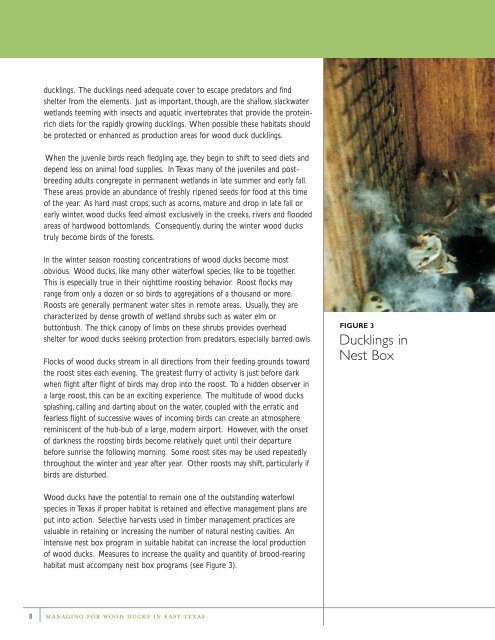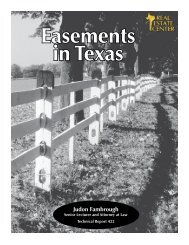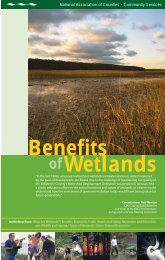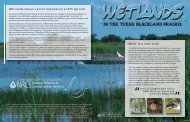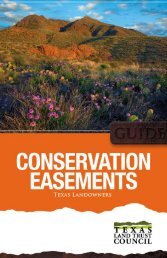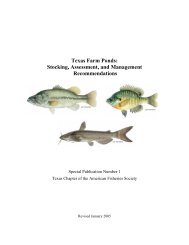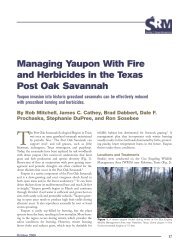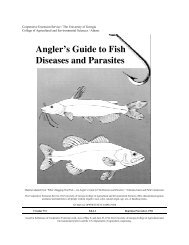Managing for Wood Ducks in East Texas - Trinity Waters
Managing for Wood Ducks in East Texas - Trinity Waters
Managing for Wood Ducks in East Texas - Trinity Waters
Create successful ePaper yourself
Turn your PDF publications into a flip-book with our unique Google optimized e-Paper software.
duckl<strong>in</strong>gs. The duckl<strong>in</strong>gs need adequate cover to escape predators and f<strong>in</strong>d<br />
shelter from the elements. Just as important, though, are the shallow, slackwater<br />
wetlands teem<strong>in</strong>g with <strong>in</strong>sects and aquatic <strong>in</strong>vertebrates that provide the prote<strong>in</strong>rich<br />
diets <strong>for</strong> the rapidly grow<strong>in</strong>g duckl<strong>in</strong>gs. When possible these habitats should<br />
be protected or enhanced as production areas <strong>for</strong> wood duck duckl<strong>in</strong>gs.<br />
When the juvenile birds reach fledgl<strong>in</strong>g age, they beg<strong>in</strong> to shift to seed diets and<br />
depend less on animal food supplies. In <strong>Texas</strong> many of the juveniles and postbreed<strong>in</strong>g<br />
adults congregate <strong>in</strong> permanent wetlands <strong>in</strong> late summer and early fall.<br />
These areas provide an abundance of freshly ripened seeds <strong>for</strong> food at this time<br />
of the year. As hard mast crops, such as acorns, mature and drop <strong>in</strong> late fall or<br />
early w<strong>in</strong>ter, wood ducks feed almost exclusively <strong>in</strong> the creeks, rivers and flooded<br />
areas of hardwood bottomlands. Consequently, dur<strong>in</strong>g the w<strong>in</strong>ter wood ducks<br />
truly become birds of the <strong>for</strong>ests.<br />
In the w<strong>in</strong>ter season roost<strong>in</strong>g concentrations of wood ducks become most<br />
obvious. <strong>Wood</strong> ducks, like many other waterfowl species, like to be together.<br />
This is especially true <strong>in</strong> their nighttime roost<strong>in</strong>g behavior. Roost flocks may<br />
range from only a dozen or so birds to aggregations of a thousand or more.<br />
Roosts are generally permanent water sites <strong>in</strong> remote areas. Usually, they are<br />
characterized by dense growth of wetland shrubs such as water elm or<br />
buttonbush. The thick canopy of limbs on these shrubs provides overhead<br />
shelter <strong>for</strong> wood ducks seek<strong>in</strong>g protection from predators, especially barred owls.<br />
Flocks of wood ducks stream <strong>in</strong> all directions from their feed<strong>in</strong>g grounds toward<br />
the roost sites each even<strong>in</strong>g. The greatest flurry of activity is just be<strong>for</strong>e dark<br />
when flight after flight of birds may drop <strong>in</strong>to the roost. To a hidden observer <strong>in</strong><br />
a large roost, this can be an excit<strong>in</strong>g experience. The multitude of wood ducks<br />
splash<strong>in</strong>g, call<strong>in</strong>g and dart<strong>in</strong>g about on the water, coupled with the erratic and<br />
fearless flight of successive waves of <strong>in</strong>com<strong>in</strong>g birds can create an atmosphere<br />
rem<strong>in</strong>iscent of the hub-bub of a large, modern airport. However, with the onset<br />
of darkness the roost<strong>in</strong>g birds become relatively quiet until their departure<br />
be<strong>for</strong>e sunrise the follow<strong>in</strong>g morn<strong>in</strong>g. Some roost sites may be used repeatedly<br />
throughout the w<strong>in</strong>ter and year after year. Other roosts may shift, particularly if<br />
birds are disturbed.<br />
FIGURE 3<br />
Duckl<strong>in</strong>gs <strong>in</strong><br />
Nest Box<br />
<strong>Wood</strong> ducks have the potential to rema<strong>in</strong> one of the outstand<strong>in</strong>g waterfowl<br />
species <strong>in</strong> <strong>Texas</strong> if proper habitat is reta<strong>in</strong>ed and effective management plans are<br />
put <strong>in</strong>to action. Selective harvests used <strong>in</strong> timber management practices are<br />
valuable <strong>in</strong> reta<strong>in</strong><strong>in</strong>g or <strong>in</strong>creas<strong>in</strong>g the number of natural nest<strong>in</strong>g cavities. An<br />
<strong>in</strong>tensive nest box program <strong>in</strong> suitable habitat can <strong>in</strong>crease the local production<br />
of wood ducks. Measures to <strong>in</strong>crease the quality and quantity of brood-rear<strong>in</strong>g<br />
habitat must accompany nest box programs (see Figure 3).<br />
8<br />
MANAGING FOR WOOD DUCKS IN EAST TEXAS


